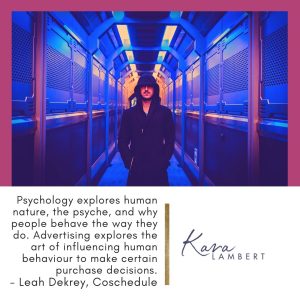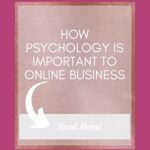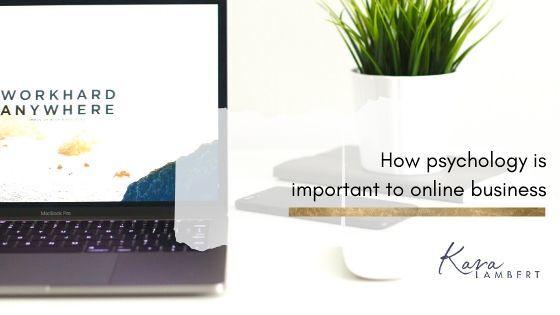Most of my clients understand that psychology is important to their business online but how is it important to your business every day? The following article outlines the main areas where understanding psychology will help your business, it also contains a number of links to helpful articles and resources so you can have a deeper understanding of specific tactics.
The psychology of online business
So let’s start with the one thing most people come to me with: The psychology of business online. There are three main issues I see. The first people talk to me about is engaging their audience online, the second is the fear of posting, and finally it’s FOMO or the fear of missing out.
The psychology of Engaging content
Businesses keep hearing that content is king and that they need to engage their audience. They try a number of different things, some realise that they have some success by just being themselves but wonder how they are going to repeat it AND sell.
This is where the psychology of engaging a business audience comes in. Platforms want us to produce content which is engaging and relevant. Businesses are realizing that their content may be neither of these and they have no idea what it means. They can take a best guess approach but really what do their clients’ think is engaging or relevant.
There is a lot of science behind it and the masters of this are a pair of Marketing Professors from Boston. You can read more about what they said was engaging social media over in this blog post I wrote.
The psychology of FOMO
The fomo is real! People hate to be left out and when we spend time online, we see all that others are doing and when we’re not – we feel left out.
I’m writing this as Australia is in the grips of the COVID-19 pandemic and I feel like every other person is adopting a kitten or a puppy. Oh how I wish I could adopt one, but I can’t. My kids see photos their friends are sharing of their new pets and they ask for one. The FOMO is real in our house.
I wrote this article on what fomo is and how to help tackle it online.
The psychology of sales in business
 If only selling were as easy as salesmen make it out to be. To be honest, it’s not a skill I excel at. One day.
If only selling were as easy as salesmen make it out to be. To be honest, it’s not a skill I excel at. One day.
I have found that there are three main arms to sales & they are the fear of selling (it’s hard to do something you’re afraid of), the psychology of pricing (we know that we all have a maximum price we will pay), and storytelling (because no one honestly likes a hard sales pitch)
So let’s get into it.
Fear of selling
They don’t want to seem pushy
Perhaps this is a particularly Australian issue, but I doubt it. We really don’t like tooting our own horn and telling people to do things. We’re more subtle with these CTAs and to be honest they come off as weak at best and ambiguous at worst.
Hate asking for the sale
Following on from not wanting to be pushy is not wanting to be salesy. In Australia there’s nothing more loathed than a slimey salesperson.
Fear of rejection
Many business owners say that they don’t use a call to action or ask for the sale because they’re afraid to be told, “no”. We want to be liked. We want to be helpful. We don’t like rejection.
There are four main ways to overcome these issues: JFDI, use courage, use psychology, outsource.
You can read more here: https://www.karalambert.com/business/call-to-action/
Psychology of pricing for your business
Back in 2016, I reviewed the research around the psychology of businesses choosing a particular price for their product or services. The most interesting discovery I had was how 9-ending prices came about and what were the psychological benefits of using 9-ending prices for business.
The psychology of 9-ending prices
We all believe that if we market our products with a 9-ending, the customers will believe it’s cheaper and will flock to buy it. Right? Well, in reality it’s more like a ‘yes & no’ or a ‘depends’.
The psychology quoted on why it works is 3 pronged:
– we read left to right and drop off the numbers on the right, being the 9
– perceived gain
– price image compared to those of a competitor
if an odd number (9 for example) followed a round number (0) then consumers believed that they were receiving a bigger discount. They also found that the perceived discount increased as the price increased. However, the effect stopped once the price reached FF 100. (This study was done in France prior to the introduction of the Euro) Similarly, Bizer & Schindler (2005) found that 9-ending prices meant that consumers estimated that they could buy more of an item than was actually possible.
if a consumer is not motivated to pay much attention to the price, then they are more likely to drop off the end numbers. So this is more likely when we really don’t have to think too much about the purchase.
when the store’s message fits with the consumer’s focus then the consumer sees it as being relevant and will remember more of the price. So, if a consumer is motivated by quality and presented with a low-price 9-ending item, they won’t remember the price as well as if they were originally looking for a cheap item.
for the drop off effect to be profitable, only 3% of items actually needed to use the principle. So to some degree it seems that businesses are actually overusing the 9-ending pricing to attract appropriately motivated clients. (Though I seriously doubt that they are properly considering the motivation of their customers)
However, Anderson & Simester offered the following practical advice:
If a product had a 9-ending price and was paired with a ‘Sale’ & a ‘New’ merchandising prompt, sales increased by 3.9%.
If a product had a 9-ending price and was paired with a ‘New’ merchandising prompt, sales increased by 8.5%.
To go deeper into your understanding of when and how to use 9-ending prices, read this blog post: https://www.karalambert.com/business/3-ways-9-ending-pricing-influence-customer-sales/
The psychology of odd & even pricing for business
 The biggest thing to consider is how good your audience is at maths. In all instances, the easiest thing is to have your price ending in a 0 or a 5, otherwise you risk confusing and losing.
The biggest thing to consider is how good your audience is at maths. In all instances, the easiest thing is to have your price ending in a 0 or a 5, otherwise you risk confusing and losing.
Here are some of the other key points from my larger article on odd and even pricing:
– Even priced products and services are perceived as being of higher quality than odd and that intention to purchase based on quality is set by what motivates the buyer.
– If you value and promote the quality of your offer, you are better off using an even price.
– The pricing of a bundle of items requires that the items be even priced but the total bundle price be odd.
– If setting suggested prices for a Pay What You Want promotion, you should only use whole dollar amounts and preferably prices that end in 5 or 0.
– Debts are more likely to be paid in full if they end in a 5 or a 0 and to consider this when looking to recover debts.
It’s funny when you read the two psychology of pricing articles together, how it becomes clear when 9 works and why you should or shouldn’t use it.
Storytelling in your business
Sales is no longer the straight forward “buy my shit because it’s awesome & I said so”, the vast majority of us research our purchase before they’re even made & with a whole internet full of information (and mis-information) – the last thing we need and want is hard old school ram it down your throat sales. It just isn’t working.
If you’ve been reading my blog for a while you would know that I like to know the deeper ‘why’ & if it can go back to something about human psychology even better. (Look you don’t study the stuff for 3 years and then spend another 5 where it’s the main focus of your day job without it being a part of your ‘why’) So it won’t come as a surprise to know that I found this article by Lou Carlozo outlining the psychology of storytelling for sales & the keys to making it work. So what are they?
Oxytocin – the love drug or one that bonds mother to baby is switched on when we read stories
Metaphors matter – the use of metaphors are important in telling stories, they’re the Vegemite to the buttery toast. (Just don’t mix your metaphors or it can get messy)
Relevance – there’s no point telling a great story if it’s not relevant to the product/service or your customer.
If you want some examples on how to get this done, then you’ll want to read the full article I wrote on how to use the psychology of storytelling in your online business.
I’ve had to split this blog. Next up you’ll learn about the psychology of the people in your business.


